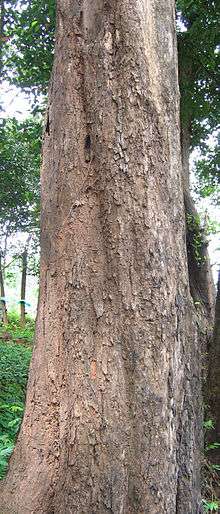Pterocarpus marsupium
| Pterocarpus marsupium | |
|---|---|
 | |
| Scientific classification | |
| Kingdom: | Plantae |
| (unranked): | Angiosperms |
| (unranked): | Eudicots |
| (unranked): | Rosids |
| Order: | Fabales |
| Family: | Fabaceae |
| Subfamily: | Faboideae |
| Tribe: | Dalbergieae |
| Genus: | Pterocarpus |
| Species: | P. marsupium |
| Binomial name | |
| Pterocarpus marsupium Roxburgh | |
| Synonyms | |
| |
Pterocarpus marsupium, also known as Malabar kino,[3] Indian kino tree or vijayasar, is a medium to large, deciduous tree that can grow up to 30 metres tall. It is native to India, Nepal, and Sri Lanka, where it occurs in parts of the Western Ghats in the Karnataka-Kerala region and also in the forests of Central India. It is also known by the names benga, bijiayasal (in western Nepal), piasal (Oriya[4]), venkai, and many others.
Uses
Parts of the Indian kino (heartwood, leaves, flowers) have long been believed to have medicinal properties in Ayurveda.
In Karnataka the plant is known as honne or kempu honne. The Kannada people in India make a wooden tumbler from the heartwood of this herb tree.

bark of Pterocarpus marsupium

Leaves
References
- ↑ World Conservation Monitoring Centre (1998). "Pterocarpus marsupium". IUCN Red List of Threatened Species. Version 2006. International Union for Conservation of Nature. Retrieved 11 May 2006. Listed as Vulnerable (VU A1cd v2.3)
- ↑ http://www.theplantlist.org/tpl/record/ild-31229
- ↑ "Pterocarpus marsupium". Natural Resources Conservation Service PLANTS Database. USDA. Retrieved 15 October 2015.
- ↑ See Table 1., S.No 25 Rout, S.D.; Thatoi, H.N. (2009). "Ethnomedical practices of Kol tribes in Similipal Biosphere Reserve, Orissa, India". Ethnobotanical Leaflets. 13 (March 1, 2009): 379–387. Retrieved May 12, 2009.
| Wikimedia Commons has media related to Pterocarpus marsupium. |
This article is issued from Wikipedia - version of the 11/7/2016. The text is available under the Creative Commons Attribution/Share Alike but additional terms may apply for the media files.
